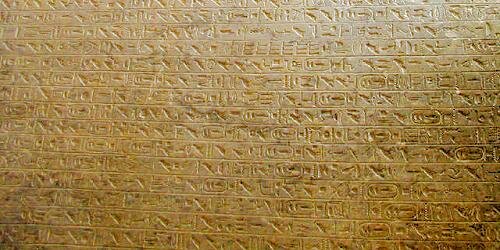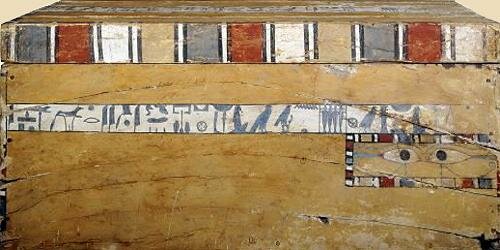|
|
|||||||||||||||||
|
|
the pyramid texts and the coffin texts For best results, we recommend that you maximise this window.
The Pyramid texts are the earliest Ancient Egyptian funerary texts. They consist of around eight hundred "spells" which are written in columns on the walls, corridors and burial chambers of pyramids. Altogether there are nine pyramids from the Old Kingdom and the First Intermediate Period which have pyramid texts. The earliest surviving texts are in the 5th Dynasty Pyramid of Unas at Saqqara. Early in 1881, Gaston Maspero was shown a series of paper impressions (known as squeezes) of a long hieroglyphic text arranged in neat vertical columns. The squeezes were shown to Maspero by Auguste Mariette who had acquired them from Heinrich Brugsch and his brother Emile. The brothers had discovered them on the walls of the crumbling pyramid of Pepy I at Saqqara.
The worlds' oldest religious literature The pyramid texts describe different stages in the rebirth of the pharaoh (or queen) into a uniquely royal afterlife within his or her pyramid, and were arranged on the walls as if to be read by the deceased from beyond the grave. As with the spells of the later Coffin Texts and the Book of the Dead, there is no one single standard edition. Each pyramid employed a different selection of spells, taken from what must have been a much larger collection of texts. Maspero's texts included more than four thousand lines of texts - the earliest, most important and extensive expression of religious thought to have survived from anywhere in the ancient world. Further royal burial chambers decorated with Pyramid Texts were later discovered, including four by the Swiss archaeologist Gustave Jéquier between 1926 and 1933. These belonged to the 8th Dynasty King Ibi and the 6th Dynasty Queens Wedjebten, Neith and Ipuit. The recent find of Ankhesenpepi at Saqqara suggests that there are doubtless more examples of texts waiting to be discovered. The Coffin Texts Coffin Texts became popular during the Middle Kingdom. Whereas the Pyramid Texts were only made available to the royalty of the Old Kingdom, the Coffin Texts were accessible to anyone who could afford them. These spells would be inscribed upon the actual coffins, usually painted in closely crowded columns of cursive hieroglyphs inside the deceased's coffin. There are over a thousand spells, and many of these texts were derived from the earlier Pyramid Texts.
The Coffin Texts were intended to provide a guarantee of survival in the afterworld, and included such titles as "Spell for not dying a second death". Many of these Coffin Texts would eventually evolve into the New Kingdom "Book of the Dead". The Coffin Texts also spoke of a belief in an afterlife spent in the Field of Reeds where agricultural tasks would be performed by the deceased for all eternity. To undertake this work for the deceased, the ushabti-formula makes its first appearance. The ushabtis were small figurines, often representing the deceased or servants of the deceased. They would act as magical substitute workers and relieve the deceased of all hard work in the afterlife. This idea was also to become incorporated into the later texts that formed the Book of the Dead. Both the Pyramid Texts and the Coffin Texts include more than one version of the destination of the deceased: they may travel the sky with the sun-god Re or they may pass down into the underworld of Osiris. This latter version became increasingly common from the time of the Coffin Texts onwards, eventually setting the scene for the funerary beliefs of the New Kingdom.
|
||||||||||||||||
|
|||||||||||||||||



